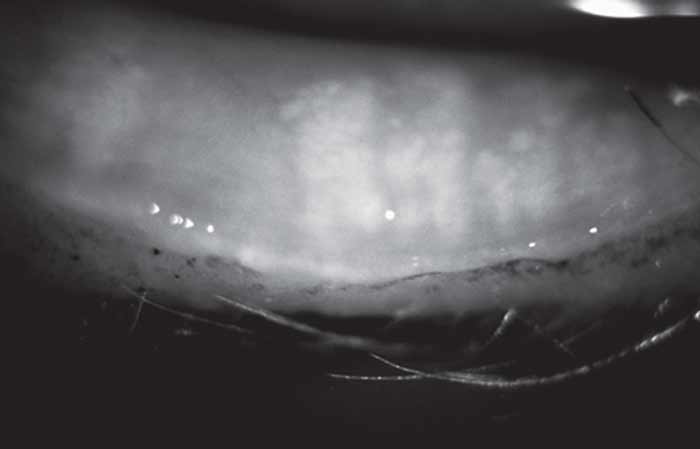 |
Oral azithromycin and doxycycline have been commonly used in the management of moderate to severe MGD when conservative therapies fail. Photo: Gregory Moore, OD. Click image to enlarge. |
Editor’s Note: As part of our “Year in Review” retrospective, we’ve selected the top 30 news stories of the year and are re-sharing them as we close out 2023. Follow along as we count down to number 1!
This story was originally published March 28, 2023.
No. 15 biggest news story of 2023:
In the moderate and severe stages of meibomian gland disorder (MGD), a six-week course of oral doxycycline, a tetracycline antibiotic with anti-inflammatory and lipid-regulating effects, is commonly recommended. However, compliance can be a problem, often due to the long course of therapy and frequent gastrointestinal adverse events. Systemically administered azithromycin has been reported to have a longer tissue half-life and fewer adverse events than doxycycline, making it an attractive alternative. Researchers recently indicated that a six-week course of daily oral doxycycline and oral azithromycin taken once a week for three weeks significantly improved both symptoms and objective measurements of MGD at the sixth and eighth weeks, respectively.1
The study, published in JAMA Ophthalmology, included a total of 137 eyes from 137 patients who were randomized into groups: 68 eyes in the azithromycin group and 69 eyes in the doxycycline group (female, 66.4%; mean age, 62). After initiating therapy, the study team assessed the total MGD score and Ocular Surface Disease Index (OSDI) score at the initial visit, at six weeks and at eight weeks and assessed adverse events at six and eight weeks. The prespecified equivalence margins for MGD score and OSDI score were set at ±2 and ±9, respectively.
The evidence of equivalency of both treatments in reducing MGD score was robust at the sixth week but not at the eighth week. The adjusted mean difference of total MGD scores between groups at week six and week eight were -0.33 and 0.13, respectively. The adjusted mean difference of OSDI between group scores at weeks six and week eight was -1.20. Patients treated with azithromycin had fewer gastrointestinal adverse events (4.4% vs. 15.9%). Two cases from the doxycycline group had premature discontinuation from the current project due to the unbearability of these gastrointestinal adverse events.
The researchers decided on the oral azithromycin regimen for their study with the knowledge that a single 1g dose can achieve a high tissue concentration in both the conjunctiva and tears for at least 14 days. They aimed to identify an effective treatment regimen with the fewest doses of medication and adverse events to maximize patient compliance.
Still, they intentionally chose a dosing schedule for doxycycline from the literature that would lead to the highest tissue levels of the drug to ensure a better comparison against a dosing schedule that provides the highest tissue levels of the drug, potentially the most effective for MGD treatment. However, lower dosing regimens of doxycycline may have been associated with a lower incidence of gastrointestinal adverse events.
The study concluded that the reduced dosing of azithromycin supports its use as an alternative to doxycycline for at least six weeks.
“However, longer-term follow-up in each group would be needed to determine if these outcomes persist for this chronic condition,” the authors of the paper wrote.1
A commentary also published in JAMA Ophthalmology took issue with the study’s design. Although there have been multiple clinical studies evaluating antibiotic treatment for MGD, there are no high-quality randomized clinical trials (RCTs) supporting their use. Major issues with prior RCTs include high attrition, selective reporting and small sample sizes with low precision and wide confidence intervals on treatment effects.2
“Absent such evidence previous to the study, there is a risk of declaring equivalence of the two antibiotics when the efficacy of one or both antibiotics may not be significantly better than a placebo,” the commentary author wrote.
“When testing an equivalence hypothesis, the efficacy of the standard active treatment must be definitively established,” she added. “This may be accomplished through inclusion of a control group in the trial allowing for a direct comparison vs. the active treatments, or alternatively, a comparison of the active groups in the trial with a historical control group of similar patients using the same outcome measures may be planned.”
“For those in clinical practice who are using oral doxycycline to treat MGD with dosing as in this trial, this trial provides strong evidence that switching to azithromycin provides similar efficacy with lower risk of gastrointestinal adverse effects,” the commentary concluded. “However, it must also be recognized there is a possibility that one or both treatments are no better than conservative management or no better than no treatment at all.”2
1. Upaphong P, Tangmonkongvoragul C, Phinyo P. Pulsed oral azithromycin vs. six-week oral doxycycline for moderate to severe meibomian gland dysfunction. JAMA Ophthalmol. March 23, 2023. [Epub ahead of print]. 2. Melia BM. Evaluating the evidence for treatment of meibomian gland dysfunction with oral antibiotics. JAMA Ophthalmol. March 23, 2023. [Epub ahead of print]. |

